Porto-North-Portugal.com
The best independent guide to Porto
Porto-North-Portugal.com
The best independent guide to Porto
Porto's 6 Bridges: The Complete Guide for 2025
The Douro is more than a river; it is the powerful force that has historically defined the cities of Porto and Gaia. For centuries, its strong currents made crossing a perilous challenge, separating the historic city on the north bank from the port wine lodges to the south. The magnificent collection of bridges that span its deep valley today reflect Porto's ambition and engineering genius, forming a unique world heritage of structural art.
These bridges tell a remarkable story of technological evolution. This legacy began in the 19th century with Gustave Eiffel’s revolutionary iron arch on the Ponte Maria Pia, which was immediately surpassed by the iconic Dom Luís I. In the 20th century, the Ponte da Arrábida held the title for the world's longest concrete arch, while in the 21st, the Ponte do Infante is celebrated for the extreme flatness and slenderness of its design.
This guide provides a complete overview of Porto’s six bridges, from the 19th-century masterpieces to the modern structures that support the city. You will also discover the stories of the tragic "lost bridges" of the past, with a map to pinpoint key locations and practical details on how to best see them.
Overview of the six bridges of Porto
Porto's six bridges are best understood in their geographical order, starting from the coast and moving inland. Here is a quick overview of each structure.
• Ponte da Arrábida (1963): A motorway bridge carrying the A1 expressway. Its giant concrete arch was once the longest of its kind in the world.
• Ponte Dom Luís I (1886): Carries the Metro on its top deck and road traffic below. This iconic double-deck iron arch is the symbol of the city.
• Ponte do Infante D. Henrique (2003): A modern road bridge. It is admired for its exceptionally slender and sleek single-arch design.
• Ponte Maria Pia (1877): A decommissioned railway bridge. This is Gustave Eiffel’s revolutionary design, now preserved as a national monument.
• Ponte de São João (1991): Used for modern railway traffic. The functional, concrete bridge that replaced the historic Ponte Maria Pia.
• Ponte do Freixo (1995): A major motorway crossing. The most upstream bridge, designed as a twin structure to bypass the city centre.
Insight: 'Ponte' is the Portuguese word for bridge.
The interactive map below shows the location of all six bridges, helping you to visualise their positions along the Douro River.
Legend: 1) Ponte da Arrábida 2) Ponte Dom Luís I 3) Ponte do Infante D. Henrique 4) Ponte Maria Pia 5) Ponte de São João 6) Ponte do Freixo
Ponte Dom Luís I
The Dom Luís I is the undisputed symbol of Porto. Its magnificent two-tiered arch is the centrepiece of the city's riverfront and a vital link connecting the historic Ribeira district with the port cellars of Vila Nova de Gaia.
When the government launched a competition for the bridge in 1879, it included one critical requirement: the structure must have two decks to connect both the low-level riverfronts and the high-level city districts. The winning design came from Théophile Seyrig, the very same engineer who had been Gustave Eiffel's partner on the nearby Ponte Maria Pia.
The construction was a triumph of 19th-century engineering. Its great bi-articulated arch spans 172 metres and, at the time of its inauguration on October 31, 1886, was the longest of its type in the world. Curiously, while the bridge is named for King Luís I, it is almost always referred to locally as Ponte Luís I, without the royal title "Dom". Legend holds that this was a permanent republican snub after the king failed to attend the grand opening ceremony.
Today, the bridge continues to serve the city, though its role has evolved. The upper deck, standing 62 metres above the river, was converted to carry the Metro's Yellow Line and a wide pedestrian walkway. The lower deck, 10 metres above the water, continues to carry road traffic and a narrow pedestrian path.
For the definitive Porto experience, you must walk across the upper deck. This high vantage point provides the most spectacular panoramic views over the terracotta roofs of the Ribeira and the sprawling cellars of Gaia. The most iconic photograph is taken from the Gaia side at sunset, from the Jardim do Morro or the terrace of the Mosteiro da Serra do Pilar, looking back towards the historic heart of Porto.
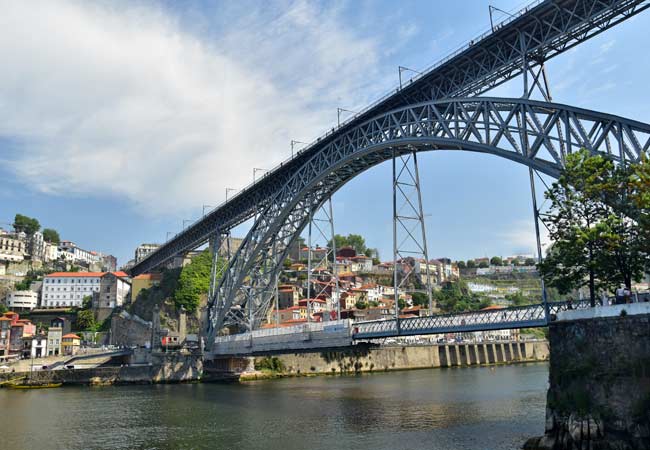
Ponte Maria Pia
Just a short distance upstream from the Dom Luís I bridge stands the elegant, lace-like form of the Ponte Maria Pia, a true masterpiece of 19th-century industrial design. This railway bridge was the creation of Gustave Eiffel’s company and was designed by Eiffel himself along with his partner, Théophile Seyrig. It was inaugurated with great fanfare by King Luís I and Queen Maria Pia, after whom it was named, on November 4, 1877.
At the time, the bridge was a revolutionary achievement. Its bi-articulated arch of wrought iron, spanning 160 metres, was the longest in the world and established Eiffel's global reputation. This very design would serve as the structural model for future marvels, including the Garabit Viaduct and the Eiffel Tower itself.
The Ponte Maria Pia served as the main rail crossing over the Douro for 114 years. It was finally decommissioned in 1991, as its single track, low speed limit of 20 km/h, and load restrictions had become a significant bottleneck for modern train services. Today, this National Monument is preserved but not open to the public. You can get an excellent view of its intricate ironwork from the riverbanks, where it stands right next to its modern replacement, the Ponte de São João, offering a striking contrast between 19th and 20th-century engineering.
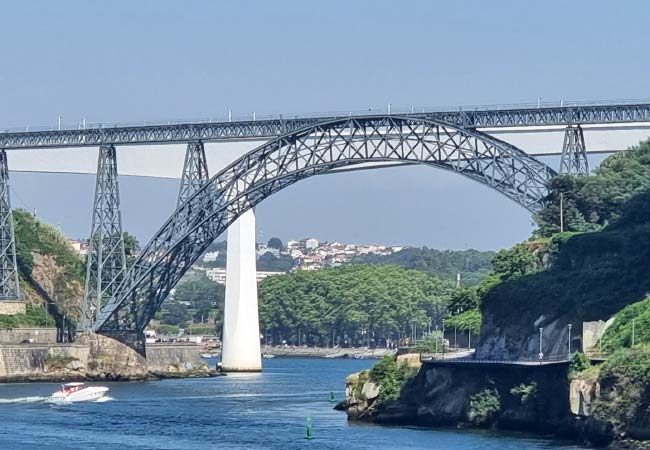
Ponte da Arrábida
The monumental Ponte da Arrábida is the bridge closest to the Atlantic Ocean, a structure born from the traffic chaos that overwhelmed the city in the mid-20th century. When it was inaugurated in 1963, its 270-metre concrete arch was the longest of its kind in the world, carrying the main A1 expressway high above the Douro.
Designed by the esteemed Portuguese engineer Edgar Cardoso, the bridge’s visual power comes from its massive double arch, formed by two parallel concrete ribs. Its construction was a landmark achievement; for the first time, a concrete arch of this immense scale was built using a metal scaffold without any intermediate supports in the river.
The four giant pillars that frame the main arch hide a curious secret. They originally housed elevators designed to help pedestrians cross between the riverside areas of Porto and Gaia. These were eventually deactivated as locals found it more practical to continue using small boats for the short journey.
For those seeking a unique experience, it is possible to join a guided tour that climbs the structure, offering fantastic 70-metre-high views over the city and the river's mouth.
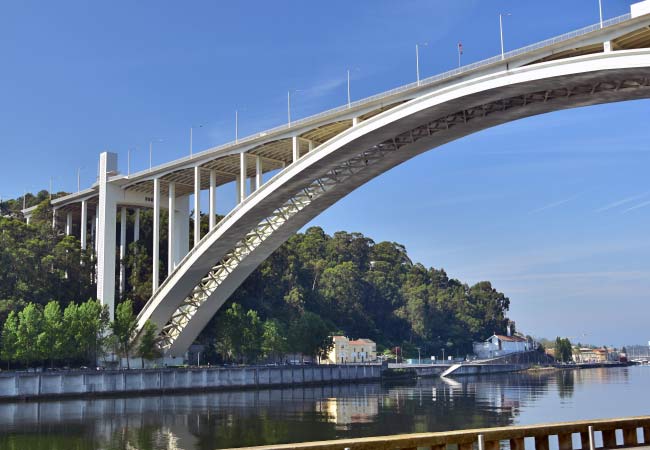
The twin parallel aches of the Ponte da Arrábida was a unique design of the era.
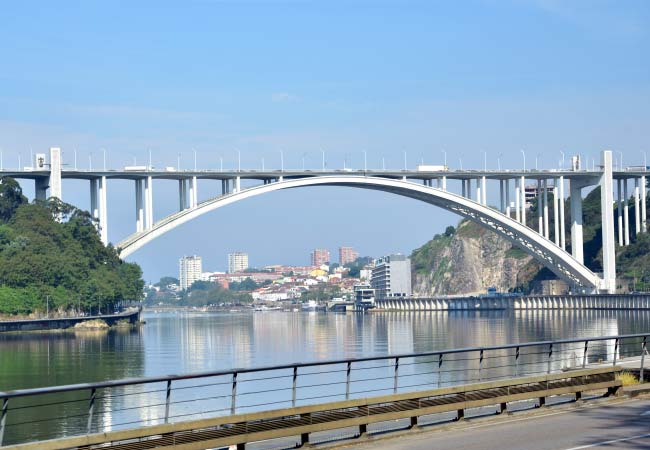
Ponte do Infante D. Henrique
Just upstream from the iron latticework of the Dom Luís I stands the clean, modern line of the Ponte do Infante D. Henrique. This elegant crossing opened on March 30, 2003, taking over road traffic and allowing its historic neighbour to be dedicated to the Metro. Named for Porto's native son, Henry the Navigator, it connects the Fontainhas area directly to the Serra do Pilar on the Gaia side.
The designers' vision was for a bridge that was deliberately discreet, honouring its two famous 19th-century neighbours rather than competing with them. Its visual lightness is intentional, with a design stripped of all decoration to express a sense of structural purity. If you look closely, you will see the structure is formed from straight lines and flat planes rather than a true curve, a functional choice that gives the bridge its unique geometric character.
This elegance hides a formidable engineering achievement. The bridge holds a world record for the flatness of its arch, with a span of 280 metres and a rise of only 25 metres. This creates a fascinating paradox: while it may be the most 'delicate' arch of its size in the world, its shallow design means it carries the largest axial force of any concrete arch ever built. Unlike a classic arch bridge, here the extremely rigid deck and the very flexible arch work together, with the deck acting like a great beam that is simply supported by the slender arch below
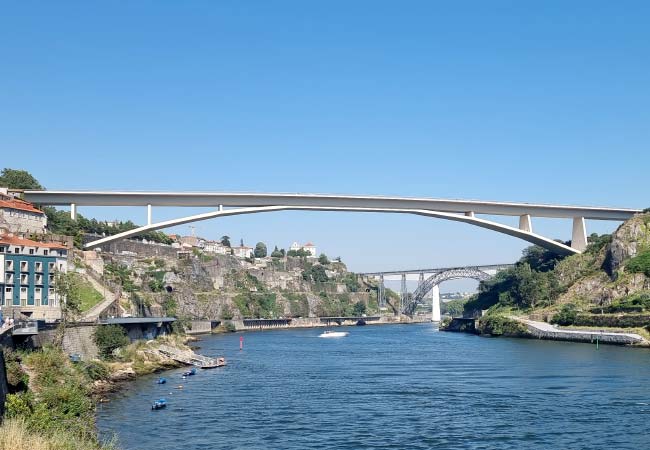
The unintrusive Ponte do Infante is almost unseen between the two classical bridge .
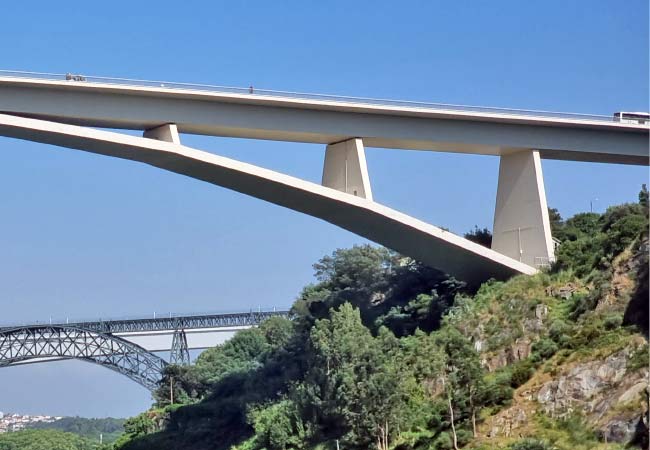
However, there are colossal forces been driven into the bedrock
Ponte de São João
Standing right beside the historic Maria Pia is its functional replacement, the Ponte de São João. Inaugurated in 1991, it was built to solve a major problem for Portugal's railway: the Maria Pia’s single track had become a serious bottleneck for the main north-south line. This new bridge allowed for double tracks and higher speeds, modernising a vital transport link.
Designed by Edgar Cardoso, the same engineer behind the Ponte da Arrábida, the bridge deliberately breaks with Porto's tradition of arch bridges. Instead, it uses a continuous portal frame design with three immense pillars, two of which are founded directly in the riverbed – a first for Porto. Its 250-metre central span set a world record for this type of railway bridge at the time of its construction. This functional design offers a clear visual contrast to the intricate 19th-century ironwork of its famous neighbour.
Ponte do Freixo
The most upstream of Porto’s crossings is the Ponte do Freixo, the great workhorse of the city’s road network. Opened in 1995, it carries the VCI, Porto’s inner ring road, allowing motorway traffic to bypass the historic city centre. Its crucial role is to keep the entire region moving. Unlike the other bridges that are set within the city's dramatic river gorge, the Ponte do Freixo crosses a much wider and gentler stretch of the Douro.
The Ponte do Freixo most fascinating feature is that it is not one structure, but two identical twin bridges running parallel, separated by a gap of just 10 centimetres. This twin design was a practical solution to handle the immense volume of traffic required for a major motorway. While the least decorative of the bridges, its sheer scale and unique parallel construction make it an impressive piece of modern infrastructure.
The Lost Bridges of Porto
Long before the era of iron, the powerful Douro River was a formidable barrier between Porto and Gaia. For centuries, the crossing relied on small boats until the first semi-permanent solution was inaugurated on August 15, 1806: the Ponte das Barcas. This ingenious bridge was a simple timber deck laid across a line of twenty barges, which could be opened to allow river traffic to pass.
The bridge's fragility led to one of Porto’s greatest tragedies. On March 29, 1809, the structure collapsed under the weight of thousands of citizens fleeing the invading French army of Marshal Soult. You can find a memorial to this event on the Ribeira waterfront today; look for a bronze relief known as the 'Alminhas da Ponte' set into the wall near the Dom Luís I bridge.
The disaster prompted the construction of a truly permanent crossing. Inaugurated in 1843, the Ponte Pênsil (officially named Ponte D. Maria II) was an engineering marvel for its time. It was a suspension bridge with a 170-metre wooden deck suspended 10 metres above the river by iron cables, which hung from four magnificent granite obelisks.
Despite its elegance, growing doubts about the bridge's structural stability and its inability to handle the city's increasing traffic led to its replacement. The Ponte Pênsil was dismantled in 1887, just one year after its successor, the Dom Luís I, was completed. Today, you can still see the two surviving obelisks and the small guardhouse on the Porto side, standing right beside the lower deck of the Dom Luís I bridge as a powerful and often-missed link to the city’s past.
If you've enjoyed our content, we'd like to ask for your support.
The internet landscape has changed, and small independent publishers like us face increasing challenges. Search engines now prioritize advertising over organic content, reducing our traffic, while AI systems increasingly copy our original work without attribution.
To help support us, please consider bookmarking our website for easy access. If you find an article useful, we encourage you to share it with friends or on social media. Equally, if you notice anything outdated or incorrect, please let us know so we can promptly address it.
We're always open to collaborating with brands, bloggers, and SEO/PR agencies who value independent creators. If you'd like to work with us or offer support, please reach out at: [email protected]
Thank you for being part of our community and helping us continue to provide valuable content in an increasingly challenging digital environment.
























